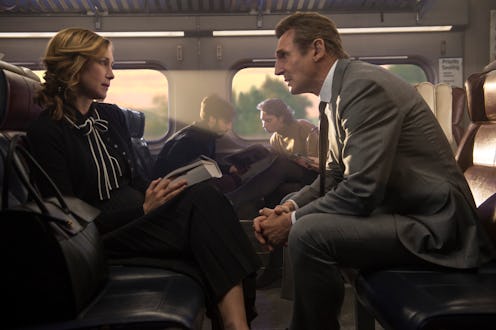Entertainment
Liam Neeson's New Thriller 'The Commuter' Seems Ripped From The Headlines
Liam Neeson's upcoming film focuses on commuting, a premise so mundane most people wouldn't think twice about it. But The Commuter, coming out Jan. 12, takes the dull but necessary shuttling between work and home and turns it into an action-packed, twist-filled thriller taking place nearly in real-time. Considering that approximately 7.65 million people travel back and forth for work on public transportation, is The Commuter based on a true story?
Surprisingly, nope. The Commuter is actually a fictional story from writers Philip de Blasi and Byron Willinger, who wrote the script over seven years ago. They've been writing steadily since, but without getting anything picked up — Hollywood can be a tough town. Lucky for them, after the script bounced around for a few years, Neeson personally chose it as his next project. Admittedly luck likely has less to do with it than the fact it's hard to imagine anyone but Neeson playing this role. A quiet family man driven to extremes by an extreme situation fights back? Sounds like the Neeson Template as used in the Taken series and Non Stop. The Commuter even reunites Neeson and Non Stop director Jaume Collet-Serra.
While The Commuter isn't based on one specific true story, everyone involve with the film realized the importance of creating a level of believability for something so many filmgoers would recognize from their daily lives. Collet-Serra emphasized the importance of the story's everyman appeal saying in a press release, "When extraordinary events happen to regular people, it's important that the first choices that these characters make are choices that we, as an audience, agree with, and that the action escalates plausibly from those choices.”
In The Commuter, Neeson's ex-cop turned business drone Michael MacCauley has just been fired from his job and is riding home to face his family with the bad news, when an offer for a ludicrous amount of cash is dropped in his lap. All he has to do, according to Vera Farmiga's mysterious Joanna, is find someone "who doesn't belong" on the train. Most of us would have the same reaction as MacCauley's — suspicious, but in for the cash. It's only when the plot thickens that we're drawn into MacCauley's main moral dilemma. What if by finding that person, you're slating them for doom? Would you still point them out? In an interview with The Movie Times, writers de Blasi and Willinger said they're "attracted to strong, dramatic questions" and threw in the twist to keep the audience engaged beyond just the mystery element.
Relatability was the name of the game, and part of keeping that up was realism. For The Commuter's similarly tri-state transportation, the crew knew they'd have to make the ride boringly believable, but not so dull people would feel like they were on their own way to work. MacCauley takes the Hudson North, an older MTA train that goes from the crowded grandeur of Grand Central through the flickering labyrinth of the Bronx, to the gorgeous scenery along New York State's Hudson River. As Collet-Serra noted in the press release, "trains can be very boring on film, but the Hudson North is an older-type train and is a little more aesthetically interesting."
Aside from a few establishing shots and exteriors, filming on a train was unrealistic, and so the team ended up building a 30-ton set using actual Metro train scraps from an Ohio junkyard. A hydraulic system gave everything that realistic train-jiggle, a small detail that absolutely tricks your brain into believing MacCauley's just riding along, before hearing the offer that will change his life.
The Commuter may not be a true story of any actual commuter, but it's the attention to that everyday experience that makes the film's outlandish premise work so well.
